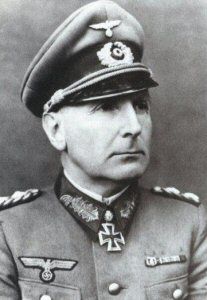Langermann und Erlenkamp, Freiherr von, Willibald
- Date of birth:
- March 29th, 1890 (Karlsruhe/Baden, Germany)
- Date of death:
- October 3rd, 1942 (near Storoshevoye/Rostov Oblast, Soviet Union)
- Nationality:
- German
Biography
Full Name: Willibald Karl Moritz Robert Rudolf Freiherr von Langermann und Erlencamp.
Promotions:
September 30th, 1908: Fahnenjunker;
October 3rd, 1909: Fähnrich;
March 22nd, 1910: Leutnant (Patent 22 maart 1908);
February 25th, 1915: Oberleutant;
June 18th, 1917: Rittmeister;
November 1st, 1930: Major;
May 1st, 1934: Oberstleutnant;
April 1st, 1936: Oberst;
March 1st, 1940: Generalmajor;
January 15th, 1942: Generalleutnant (RDA 1 maart 1942);
June 1st, 1942: General der Panzertruppen.
Career:
September 30th, 1908: Rheinisches Dragoner-Regiment „Freiherr von Manteuffel" Nr. 5;
August 1st, 1914: Adjutant, Reserve-Dragoner-Regiment Nr. 7;
August 27th, 1915: Kompanieführer 21. Reserve-Division;
August 15th, 1916: Generalstab X. Reserve-Korps;
November 29th, 1916: Generalstab 22. Reserve-Division;
August 5th, 1918: 3. Schlesisches Dragoner-Regiment Nr. 15;
January 27th, 1920: 2. Rheinisches Husaren-Regiment Nr. 9;
April 1st, 1921: Reiter-Regiment 16;
June 15th, 192: Chef, 1. (Preuß.) Eskadron, Reiter-Regiment 16;
October 1st, 1927: Chef 1. Eskadron, 13. (Preuß.) Reiter-Regiment;
October 1st, 1930: Kavallerieschule Hannover;
November 1st, 1930: Lehrer, Kavallerieschule Hannover;
June 15th, 1935: Kommandeur 4. (Preuß.) Reiter-Regiment;
October 6th, 1936: Kommandeur Reiter-Regiment Postdam;
1937: Kommandeur Kavallerie-Regiment 4;
November 10th, 1938: Höheren Kavallerie-Offizier I;
November 24th, 1938: Inspekteur der Inspektion des Reit- und Fahrwesens (In 3), Oberkommando des Heeres;
December 4th, 1939: Führer Divisionsstab z.b.V. 410;
May 7th, 1940 - June 30th, 1940: Kommandeur 29. Infanterie-Division;
September 8th, 1940 - December 27th, 1941: Kommandeur 4. Panzer-Division;
January 8th, 1942: mit der Führung beauftragt XXIV. Armeekorps (motorisiert);
April 1st, 1942: Kommandierender General XXIV. Armeekorps (mot.);
June 21st, 1942 - October 3rd, 1942: Kommandierender General XXIV. Panzerkorps.
Do you have more information about this person? Inform us!
- Period:
- Second World War (1939-1945)
- Rank:
- Generalmajor (Brigadier)
- Unit:
- Kommandeur, 29. Infanterie-Division (motorisiert), Heer
- Awarded on:
- May 30th, 1940
- Period:
- Second World War (1939-1945)
- Rank:
- Generalmajor (Brigadier)
- Unit:
- Kommandeur, 29. Infanterie-Division (motorisiert), Heer
- Awarded on:
- June 14th, 1940
- Period:
- Second World War (1939-1945)
- Rank:
- Generalmajor (Brigadier)
- Unit:
- Kommandeur, 29. Infanterie-Division (motorisiert), Heer
- Awarded on:
- August 15th, 1940
“Generalmajor Freiherr von Langermann und Erlencamp significantly contributed to the success of the great breakthrough and encirclement operation as a result of his leadership qualities and personal example in the foremost line. He is had a major share in victories that included the seizure of the Chalons depot, the overcoming of the Rhine-Marne Canal, the reaching of the Swiss border and the difficult clearing operation in the Swiss Jura mountains.”
178th Heer Award.
- Period:
- Second World War (1939-1945)
- Rank:
- Generalmajor (Brigadier)
- Unit:
- Kommandeur, 4. Panzer-Division, Heer
- Awarded on:
- February 17th, 1942
75st Award.
At the time of the actual awarding he already served as Führer (mit der Führung beauftragd) XXIV. Armeekorps (motorisiert).
- Period:
- Second World War (1939-1945)
- Rank:
- General der Panzertruppen (Lieutenant-General of Armoured Forces)
- Unit:
- Kommandierender General, XXIV. Panzerkorps, Heer
- Awarded on:
- October 5th, 1942
"In the fighting on the Don front the commanding general of an armored corps, General der Panzertruppen Freiherr von Langermann und Erlencamp, bearer of the Oak Leaf to the Knight's Cross of the Iron Cross, met an heroic death on 3 October 1943 on the front line. Side by side with him fell the commander of a Hungarian division, Colonel Nagy, in the struggle for the freedom of Europe."
Mentioned posthumously.
- Period:
- Second World War (1939-1945)
- Period:
- Second World War (1939-1945)
- Period:
- Second World War (1939-1945)
- Period:
- Second World War (1939-1945)
- Period:
- Second World War (1939-1945)
- Period:
- Second World War (1939-1945)
- Period:
- First World War (1914-1918)
- Period:
- First World War (1914-1918)
Sources
- Photo 1: Gareth Collins
- Photo: Gareth Collins via Axis Biographical Research
- - FELLGIEBEL, W.P., Elite of theThird Reich, Helion & Company Limited, Solihull, 2003.
- KURSIETIS, A.J., The Wehrmacht at War 1939-1945, Uitgeverij Aspekt, Soesterberg, 1999.
- THOMAS, FRANZ & WEGMANN, GÜNTER, Die Eichenlaubträger 1940-1945, Biblio-Verlag, 1998.
- Götte, F. & Peiler, H., Die 29.Falke-Division – 1936-1945 29.I.D.-29.I.D. (mot)-29.Pz.Gren.Div., Nebel Verlag GmbH, Eggolsheim, Deutschland, 2003
- Helden der Wehrmacht II, Sammelband (Miscellany), FZ-Verlag GmbH, München, Deutschland, 2003
- Die Eichenlaubträger 1940-1945, Deutsches Wehrkundearchiv, 2001
- Axis Biographical Research
- Die Tapfersten
















